Question
I'll get straight to the narrow point ahead:
I'd like an expert's opinion on the appropriate use of Bessel when considering a specific 4th order bandpass design.
I don't mind a more general answer, so long as I can directly make deductions from the answer into specific situations so that I know when to use the term and when to avoid it for some particular case I'm considering.
Some background context will be needed.
Background
A recent question, Bandpass filter frequency response not the same as the one taken from analog filter wizard, left me wondering about the meaning of Bessel. (And, in general, other filter names that I may misuse out of ignorance.)
The above question includes a 4th order bandpass design. I am comfortable with KCL, comfortable using symbolic software for solving sets of equations. I can readily develop the transfer function for the circuit presented there. That's not the stopper.
What took me up short were two things:
The provided Bode plot just didn't look like a Bessel filter to me, which from earlier experience doesn't look pinched near the center-frequency. That plot was decidedly pinched in order to narrow its bandpass width. Which meant a high \$Q\$ was applied. And Bessel just isn't high \$Q\$ in my book.
The circuit was taken from Analog's filter design website, where it was labeled a 4th order Bessel filter.
So I was left wondering.
The author was looking for \$f_{_\text{p}}\approx 5.5\:\text{kHz}\$ (actually, it was \$f_{_\text{p}}=\sqrt{5\:\text{kHz}\cdot 6\:\text{kHz}} \approx 5.477\:\text{kHz}\$) and a passband width of \$1\:\text{kHz}\$. In this example case, the fractional bandwidth is only about 18% and a true 4th order filter (not overlapping a lowpass and a highpass) is indicated. I'm guessing that the software felt this implies \$Q\ge 5\$. And that's pretty much what the Bode plot was showing me.
But that's not my understanding of a Bessel filter, either.
So that's why I'm here asking this question.
Either my own understanding that a 4th order Bessel filter has a very specific homogeneous response is right and the use of the term on the Analog site is, at best, "very flexible." Or else I have an overly-narrow viewpoint and I've simply failed to take into account a larger view that I've been missing.
I'd like to know which it is.
Homogeneous response for a 4th order Bessel
Up to now, I've imagined the homogeneous response for a 4th order Bessel filter is \$H^{n=4}_s=s^4+10s^3+45s^2+105s+105\$. The general approach for Bessel is that given the loss function \$H^n_s=\frac1{G^n_s}\$, then the zeros (which were poles in \$G_s\$ but are now zeros) can be found by solving \$s H^{''}_s-2\left(s+n\right)H^{'}_s+2nH_s=0\$, where in this case \$n=4\$. If you apply that to \$s^4+10s^3+45s^2+105s+105\$ you will find it does simplify out to zero, as expected. This fact tends to confirm my expectations.
\$s^4+10s^3+45s^2+105s+105\$ can be factored into two 2nd order homogeneous responses, each with their own independent shape and pole frequency -- neither of which are the same as each other:
$$\begin{align*} \omega_{\text{p}_1}&=3.38936579272158\:\frac{\text{rad}}{\text{s}} & \zeta_1&=0.620702965049498 & Q_1&=0.805538281841666 \\\\ \omega_{\text{p}_2}&=3.02326493881663\:\frac{\text{rad}}{\text{s}} & \zeta_2&=0.957974461859108 & Q_2&=0.521934581668980 \end{align*}$$
You can also solve \$s^4+10s^3+45s^2+105s+105\$ to find the peak (by computing the magnitude and solving for its derivative equal to zero) at \$\omega_{\text{p}}=3.27676729191795\:\frac{\text{rad}}{\text{s}}\$.
But there are a few consistencies in the relationships between these two 2nd order factors that I expect to find in any Bessel bandpass filter. The first is that the values of \$\zeta_1\$ and \$\zeta_2\$ are immutable. All 4th order Bessel bandpass filters should, when factored, exhibit two 2nd order bandpass filters with those two damping factors (or Q's.) The second is that I'd expect the relationships between all three angular frequencies should remain such that when given a 4th order \$\omega_{\text{p}}\$ I'd be setting the two 2nd order filters for:
$$\begin{align*} \omega_{\text{p}_1}&=\frac{3.02326493881663}{3.27676729191795}\cdot \omega_{\text{p}}=0.922636449122714\cdot \omega_{\text{p}} \\\\ \omega_{\text{p}_2}&=\frac{3.38936579272158}{3.27676729191795}\cdot \omega_{\text{p}}=1.03436267844877\cdot \omega_{\text{p}} \end{align*}$$
As shown above, there's no problem moving all this around to any particular desired angular frequency. A Bessel is a Bessel no matter where it is located in the frequency domain. It's the shape that defines it, not the location of its angular frequency.
So I thought.
But it's been my assumption that you cannot mess with the shape factors, nor mess with the relative relationships of the poles, and still consider it to be a Bessel filter.
Confirmation using tables
An earlier question here, Transfer function of Bessel filter, shows the following table (taken from Ron Mancini's "Op Amps For Everyone", August 2002, SLOD006B, I think):
I've circled the relevant row. Below, is also the book's low-pass form (which is the basic form used by book and translated to bandpass or highpass, as needed.) I've included it, as well, to be sure we are all on the same page.
I can compute \$\zeta\$ easily from these factors: \$\zeta_i=\frac{a_i}{\sqrt{4\,\cdot\, b_i}}\$. Here, I get \$\zeta_{i=1}=\frac{1.3397}{\sqrt{4\,\cdot\, 0.4889}}\approx 0.9580\$ and \$\zeta_{i=2}=\frac{0.7743}{\sqrt{4\,\cdot\, 0.3890}}\approx 0.6207\$.
Please note that these match up very closely to the analytic values I came up with, earlier.
So here I've referred to a Bessel table provided in a well-known book on opamps and filter design and I'm finding similar results.
And this sharpens my question about terminology.
Coming back to Analog's filter website
I tend to imagine a 4th order Bessel bandpass looking like the green trace, not the red trace, shown below:
Sure, you can start with a Bessel and then mess around with the damping factors to increase the Q and get the red shape. But in my opinion, doing that means it is no longer a Bessel. Note the group delay behavior between the two?? The red just isn't Bessel to me.
There's another detail, by the way, about Analog's filter designer results. It follows the advice for 4th order bandpass filters found in "Op Amps For Everyone":
Note that it is quite explicit about using the exact same \$Q\$ for both 2nd order sections! Yet I know that it should not be done that way for a Bessel!
Yes, I know that makes filter design "for everyone" a lot easier. And I've no problem with the book's approach. My problem is with the Analog website's use of terms.
Let's have a look at the resulting circuit and then perform some calcs:
I won't belabor the KCL here for the MFB stages and instead just publish out result of a KCL analysis:
# r1a is the input resistor; for example, 2.18k in stage A
# r2a is the resistor to the reference; for example, 56 in stage A
# r3a is the feedback resistor; for example, 5.35k in stage A
# c1a is the feedback capacitor
# c2a is the capacitor to the minus opamp input
#
mfb
{omega: sqrt(r1a + r2a)/(sqrt(c1a)*sqrt(c2a)*sqrt(r1a)*sqrt(r2a)*sqrt(r3a)),
zeta: sqrt(r1a)*sqrt(r2a)*(c1a/2 + c2a/2)/(sqrt(c1a)*sqrt(c2a)*sqrt(r3a)*sqrt(r1a + r2a)),
P: [{A: -c2a*r3a/(r1a*(c1a + c2a)), N: 1}]}
Now, let's compute some values:
stageA = { r1a:2.18e3, r2a:56, r3a:5.35e3, c1a:51e-9, c2a:51e-9 }
stageB = { r1a:2.23e3, r2a:56.2, r3a:5.47e3, c1a:56e-9, c2a:56e-9 }
(mfb[omega].subs(stageA)/2/pi).n() # pole frequency for stage A (in Hz)
5774.13194620245
(mfb[omega].subs(stageB)/2/pi).n() # pole frequency for stage B (in Hz)
5190.09087797020
(1/2/mfb[zeta].subs(stageA)).n() # Q for stage A
4.94949095175659
(1/2/mfb[zeta].subs(stageB)).n() # Q for stage B
4.99459396879013
The pole frequency ratios are close to what I'd expect for the pair of 2nd order stages used for a 4th order Bessel -- except that they aren't quite (because they instead used identical \$Q\$s for both stages.) But I don't think the \$Q\$'s should be the same for a 4th order Bessel. (Note that they are, in fact, about 5 as I'd expected.) I just don't think those are the right \$Q\$'s for a Bessel.
Okay. That's it. I'm done posing the question(s).
Sure. I get it that Analog's site allows the use of commonly used specifications, such as the passband. And it does whatever is required in order to achieve the specifications, even if that means a very high \$Q\$ must be used.
I wouldn't have it any other way!
But the point here is about the use of Bessel to describe the result. It may be roughly in that general direction. It may be the fastest settling option given the specifications that were accepted for the filter. But being the fastest settling under the set of circumstances doesn't make it a Bessel in my mind. It's just the closest you can get to one. But it's not one.
That's my thoughts about it.
But what's the real story?
Notes
Just for reference, one can find the Bessel polynomials at this Wiki site:
